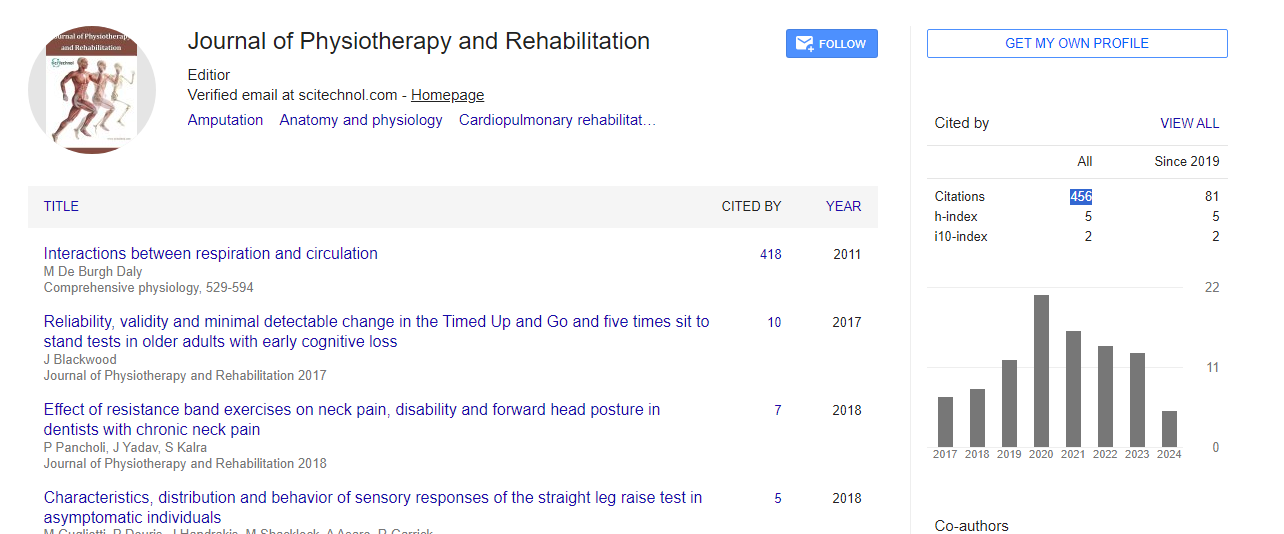Perspective, J Physiother Rehabi Vol: 8 Issue: 3
Outcomes of Robotic Rehabilitation: Insights from Clinical Studies
Xie Pisla*
1Department of Rehabilitation Medicine, Iwate Medical University, Morioka, Japan
*Corresponding Author: Xie Pisla,
Department of Rehabilitation Medicine, Iwate
Medical University, Morioka, Japan
E-mail: pisla@xie.jp
Received date: 28 May, 2024, Manuscript No. JPTR-24-140180;
Editor assigned date: 30 May, 2024, PreQC No. JPTR-24-140180 (PQ);
Reviewed date: 13 June, 2024, QC No. JPTR-24-140180;
Revised date: 21 June, 2024, Manuscript No. JPTR-24-140180 (R);
Published date: 28 June, 2024, DOI: 10.4172/JPTR.1000165.
Citation: Pisla X (2024) Outcomes of Robotic Rehabilitation: Insights from Clinical Studies. J Physiother Rehabi 8:3.
Description
Robotic rehabilitation integrates robotics technology with therapeutic interventions to assist individuals in regaining movement, strength, and function following injury or neurological impairment. These systems employ robotic devices such as exoskeletons, robotic arms, and virtual reality interfaces to provide tailored, repetitive, and precise movements that facilitate neuroplasticity and muscle retraining. Robotic rehabilitation has emerged as a transformative approach in physical therapy, offering advanced technologies designed to enhance recovery outcomes for patients with various neurological and musculoskeletal conditions. This article delves into the insights gleaned from clinical studies on the outcomes of robotic rehabilitation, highlighting its effectiveness, benefits, and future implications in the field of rehabilitation medicine.
Insights from clinical studies
Clinical studies have demonstrated the efficacy of robotic rehabilitation in improving motor function among individuals with neurological conditions like stroke, spinal cord injury, and cerebral palsy. For instance, a meta-analysis published in Neurorehabilitation and Neural Repair reviewed multiple Randomized Controlled Trials (RCTs) and concluded that robotic-assisted therapy significantly enhances motor recovery compared to conventional therapy alone. These findings highlight the capacity of robotic systems to provide intensive, repetitive training that promotes neural repair and functional gains. Robotic devices enable precise control over movement parameters, allowing therapists to tailor rehabilitation protocols to individual patient needs. Studies have shown that targeted robotic therapy can lead to improvements in muscle strength, joint range of motion, and coordination. For example, research published in
Archives of Physical Medicine and Rehabilitation reported significant gains in upper limb function among stroke survivors undergoing intensive robot-assisted therapy. These improvements contribute to greater independence in activities of daily living and overall quality of life.
Robotic rehabilitation is advance principles of motor learning by providing repetitive, task-specific training that encourages neuroplastic changes in the brain. By engaging patients in interactive tasks and virtual environments, robotic systems stimulate neural pathways associated with motor control and sensory feedback. This approach is particularly beneficial for patients recovering from stroke, where relearning motor skills is crucial for functional recovery. Studies have indicated that robotic therapy can enhance cortical reorganization and promote adaptive changes in neural circuits, supporting long-term recovery outcomes.
Comparative studies have explored the efficacy of robotic rehabilitation versus conventional therapy approaches. While both methods aim to improve functional outcomes, robotic systems offer distinct advantages in terms of intensity, precision, and feedback mechanisms. A systematic review published in Journal of Rehabilitation Medicine found that robotic-assisted therapy yielded comparable or superior outcomes in upper limb rehabilitation compared to traditional methods, suggesting its potential as a complementary approach in rehabilitation settings. Patient engagement plays a pivotal role in rehabilitation success. Robotic systems enhance engagement by providing interactive feedback, gamification elements, and real-time performance metrics that motivate patients during therapy sessions. Studies have indicated high levels of patient satisfaction and adherence to robotic rehabilitation programs, attributing these factors to increased motivation, goaloriented tasks, and personalized feedback that enhance therapeutic experiences.
Conclusion
Robotic rehabilitation holds promise as a transformative paradigm in rehabilitation medicine, offering innovative solutions to enhance recovery outcomes and quality of life for individuals with neurological and musculoskeletal disorders. By leveraging insights from clinical studies, healthcare providers can advance evidence-based practice, improve patient care, and ultimately, empower patients to achieve optimal functional independence and well-being key considerations for future research include exploring long-term outcomes, costeffectiveness analyses, integration of artificial intelligence for personalized therapy, and enhancing accessibility of robotic systems in healthcare settings.
 Spanish
Spanish  Chinese
Chinese  Russian
Russian  German
German  French
French  Japanese
Japanese  Portuguese
Portuguese  Hindi
Hindi 